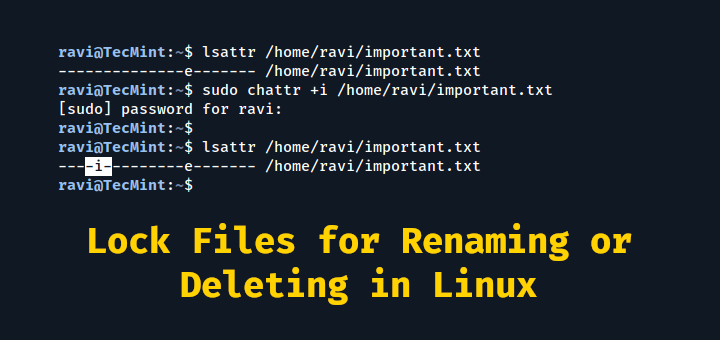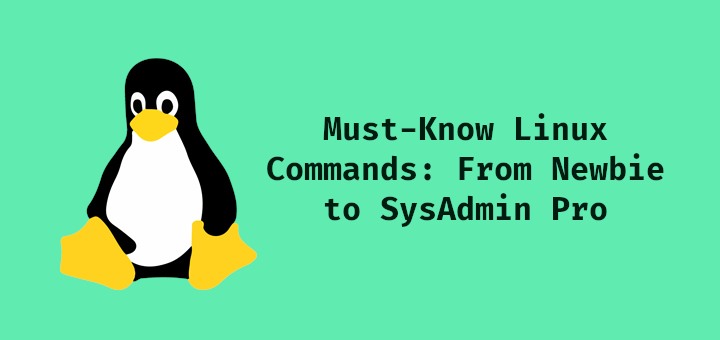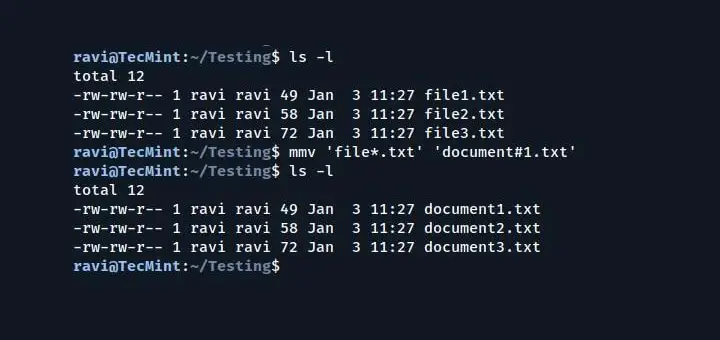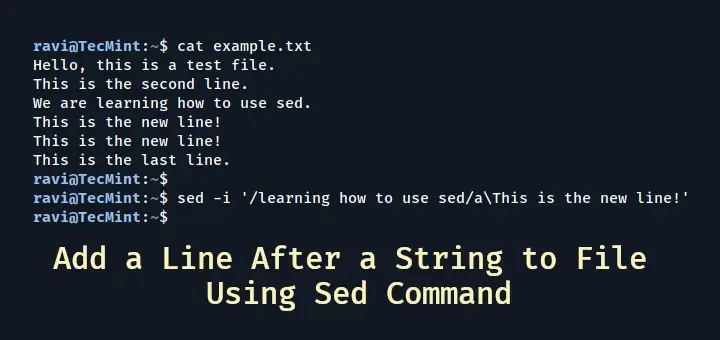You may have found the first article, ‘Useful Commands for Beginners‘ very helpful, as it was intended for newbies, this article is tailored for middle-level and advanced users.
It covers topics such as customizing search, understanding processes and how to terminate them, optimizing the Linux terminal for productivity, and compiling C, C++, and Java programs in a Unix-like environment.
21. find Command
The find command is used to search for files in the given directory, hierarchically starting at the parent directory and moving to sub-directories.
find -name *.sh
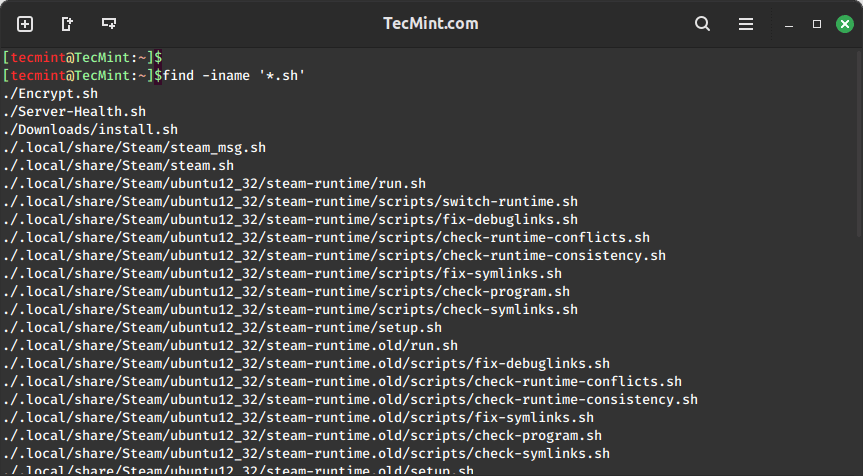
The -name option makes the search case sensitive. You can use the -iname option to find case-insensitive files with different capitalization patterns in the extension.
The * is a wildcard and searches all the files having an extension .sh you can use a filename or a part of the file name to customize the output.
find -iname *.SH
The following command is used to search for all files having extension ".tar.gz" in the current directory and its subdirectories including mounted devices.
find -name *.tar.gz
22. grep Command
The grep command searches a specified file for lines that contain a match to provided strings or words.
In this case, it is used to search for the ‘tecmint‘ user in the ‘/etc/passwd‘ file.
grep tecmint /etc/passwd
The -i option is used to search for the string “TECMINT” (case-insensitive) in the ‘/etc/passwd‘ file.
grep -i TECMINT /etc/passwd
The -r option is used to recursively search for the string “127.0.0.1” in the ‘/etc/hosts‘ file.
grep -r "127.0.0.1" /etc/hosts
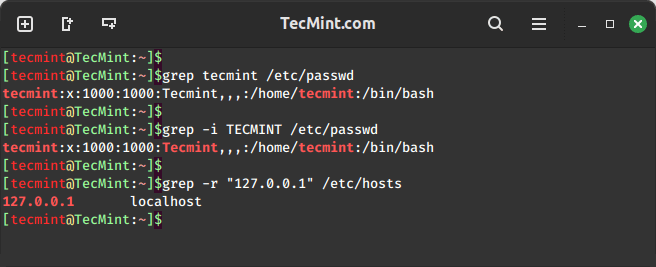
23. man Command
The man command is the system’s manual pager, which provides online documentation for all the possible options with a command and its usage.
Almost all the Linux commands come with their corresponding manual pages. For example, the following ‘man cat‘ (Manual page for cat command) and ‘man ls‘ (Manual page for command ls) display the manual pages for a given command.
man cat man ls
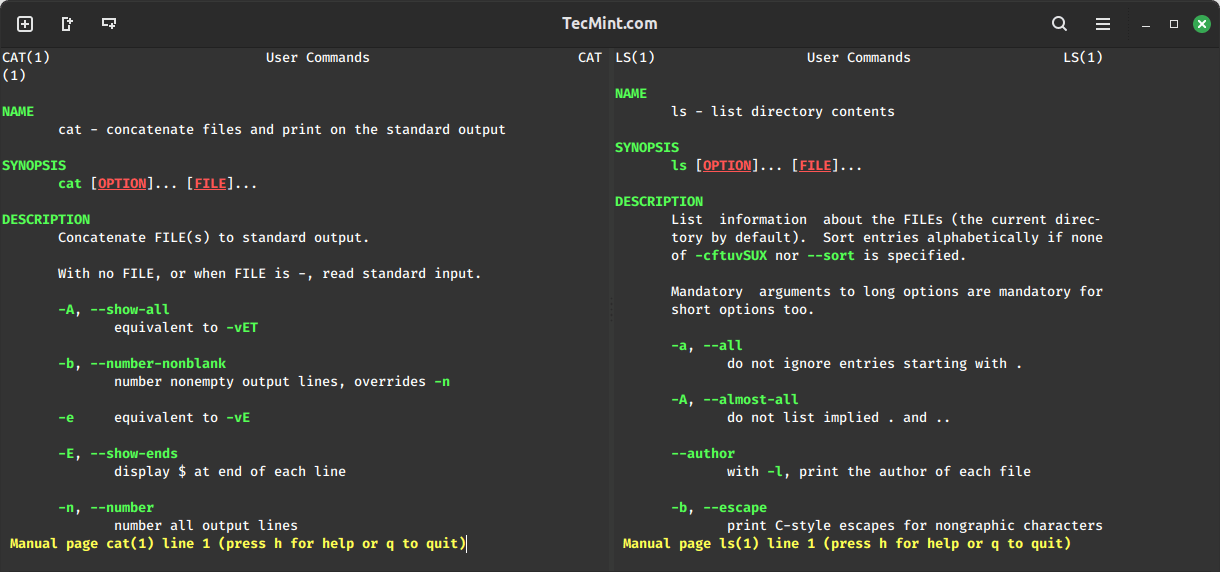
24. ps Command
The ps command gives the status of running processes with a unique ID called PID.
ps
To list status of all the processes along with process ID and PID, use option -A.
ps -A
The ps command is very useful when you want to know which processes are running or may need PID sometimes, for a process to be killed. You can use it with the grep command to find customized output.
ps -A | grep -i ssh
Here ps is pipelined with grep command to find customised and relevant output of our need.
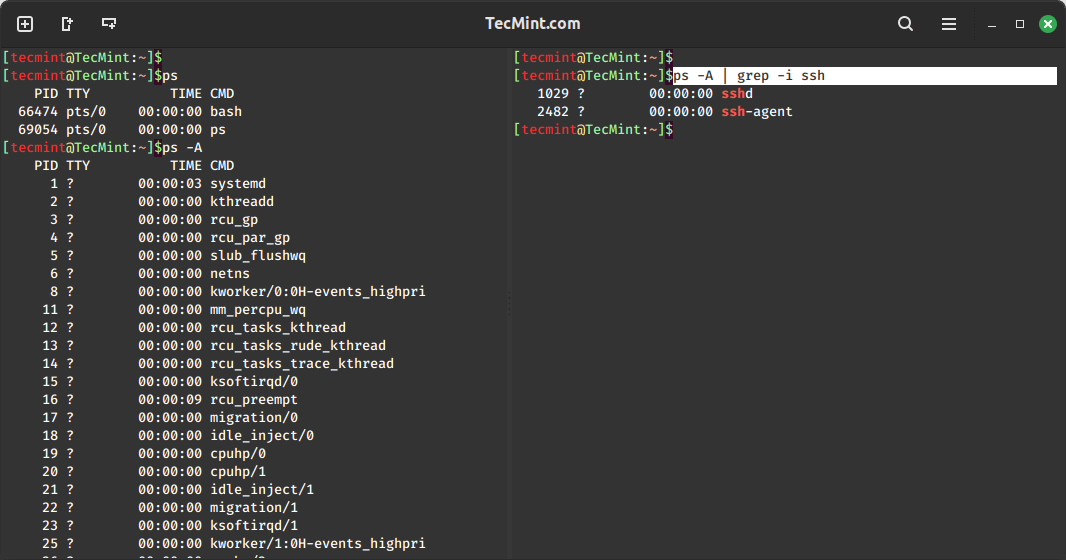
25. kill Command
The kill command in Linux is crucial for terminating unresponsive or irrelevant processes efficiently. Unlike Windows, where restarting is often required after killing a process, Linux allows you to kill and restart processes without rebooting the entire system.
For example, if you need to terminate the ‘firefox‘ program if it’s not responding, you can use the ps command along with grep to find the process pid and then use the ‘kill‘ command to stop the process.
ps -A | grep -i firefox kill 69881
Every time you re-run a process or start a system, a new pid is generated for each process and you can know about the currently running processes and their pid using the command ‘ps‘.

Another way to kill the same process is.
pkill apache2
The kill command requires job id/process id for sending signals, whereas, in pkill, you have an option of using a pattern, specifying process owner, etc.
26. whereis Command
The whereis command is used to locate the Binary, Sources, and Manual Pages of the command.
For example, to locate the Binary, Sources, and Manual Pages of the command ‘ls‘ and ‘kill‘.
whereis ls whereis kill
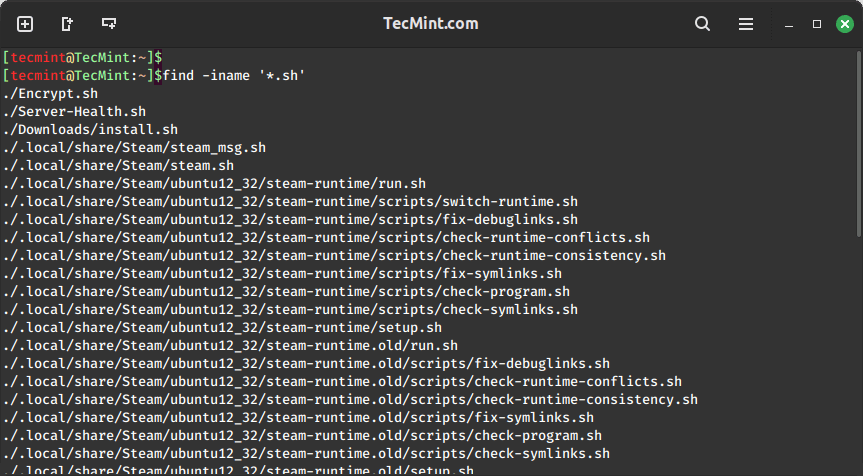
The whereis command is useful to know where the binaries are installed for manual editing sometimes.
27. systemctl Command
The systemctl command controls the starting, stopping, restarting, enabling, disabling, and checking of the status of a service or program.
sudo systemctl start sshd sudo systemctl stop sshd sudo systemctl restart sshd sudo systemctl enable sshd sudo systemctl disable sshd sudo systemctl status sshd
28. alias Command
The alias command is a built-in shell command that lets you assign a name for a long command or frequently used command.
I frequently use the ‘ls -l’ command, which consists of 5 characters, including spaces. Therefore, I created an alias for it as 'l'.
alias l='ls -l'
check if it works or not.
l
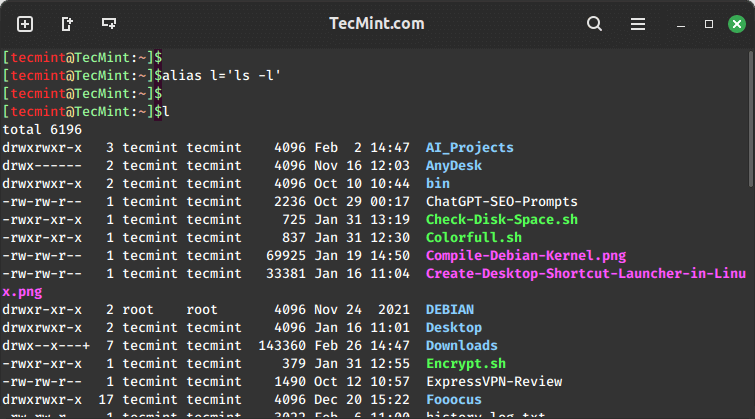
To remove alias 'l', use the following ‘unalias‘ command.
unalias l
check, if ‘l‘ still is an alias or not.
l l: command not found
Adding a bit of fun to Linux commands by creating aliases for specific important commands to other important commands.
alias cd='ls -l' (set alias of ls -l to cd) alias su='pwd' (set alias of pwd to su)
Now, imagine the humor when your friend types the cd command, expecting to change directories but instead gets a directory listing. Similarly, if he attempts ‘su‘, all he sees is the location of the working directory.
You can remove the alias later using the ‘unalias‘ command, as explained above.
29. df Command
The df command is used to show the information about disk space usage on the file system. It shows the total, used, and available space on each mounted file system.
df -h
The -h option is used to print the disk space usage in a human-readable format, showing sizes in gigabytes (GB) and megabytes (MB) for each mounted file system on your system.
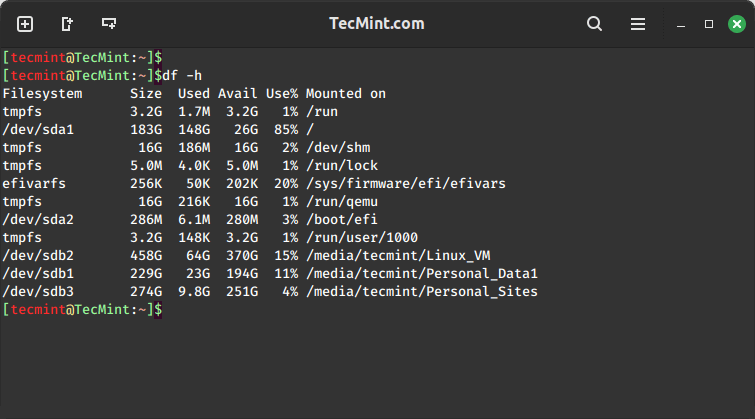
30. du Command
The du command is used to show the disk space usage of files and directories, which includes the total disk space occupied by a specific file or directory, including the space used by its subdirectories.
du -h
The -h option is used to print the file usage in a human-readable format, showing sizes in gigabytes (GB) and megabytes (MB).
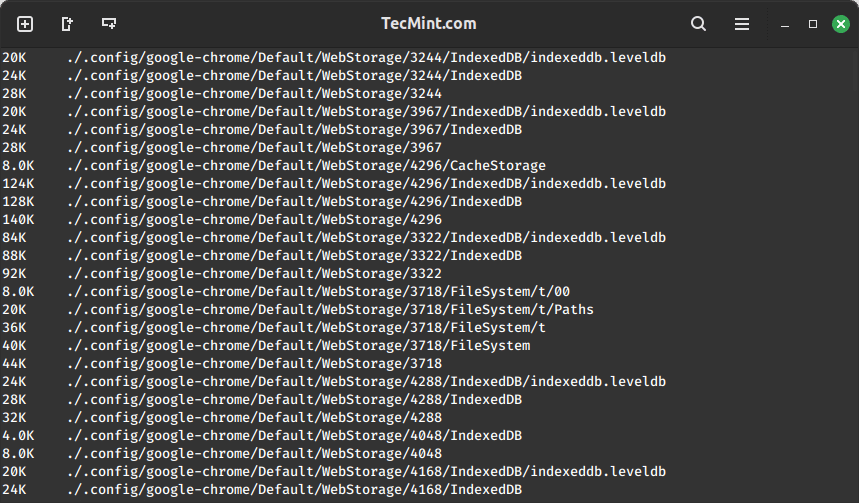
31. rm Command
The rm command stands for remove, which is used to remove or delete files and directories permanently from the file system.
The basic syntax for removing a file is:
rm file
The basic syntax for removing a directory is:
rm -rf directory
The -r (recursive, removes directories and their contents) and -f (force remove files without prompts for confirmation).
The "rm -rf" command is a destructive command. If you accidentally execute it in the wrong directory, all files and the directory itself are permanently lost.
32. echo Command
The echo command as the name suggests echoes a text on the standard output. It has nothing to do with the shell, nor does the shell read the output of the echo command.
However, in an interactive script, an echo passes the message to the user through the terminal. It is one of the commands that is commonly used in scripting, interactive scripting.
echo "Tecmint.com is a very good website" Tecmint.com is a very good website
Let’s create a small interactive bash script that will display a personalized welcome message on the terminal.
#!/bin/bash echo "Welcome to the Interactive Welcome Script!" echo "----------------------------------------" # Prompt the user to enter their name echo "Please enter your name:" read name # Display a personalized welcome message echo "Hello, $name! Welcome to the interactive script. Have a great day!"
Save this script in a file, for example, welcome_script.sh, and make the script executable using the command.
chmod +x welcome_script.sh
Then, you can run it by typing in the terminal.
./welcome_script.sh
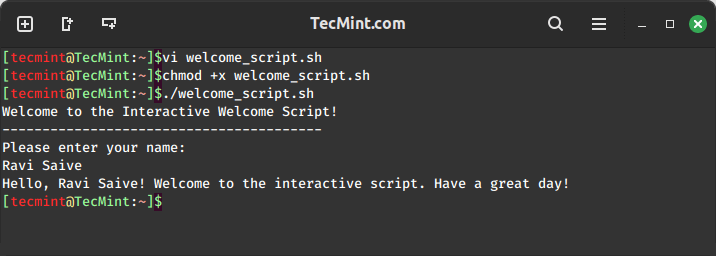
33. passwd Command
The passwd command is used to change own password or another user’s password when executed by the sudo privileges.
For example, to change the password for the current user, simply type:
passwd
If you have the sudo privileges, you can change another user’s password by specifying the username:
sudo passwd username
34. lpr Command
The lpr command is used for submitting print jobs to a printer. It sends files to a printer’s print queue, allowing users to print documents from the command line.
lpr document.txt
The ‘lpq‘ command lets you view the status of a printer (whether it’s up or not), and the jobs (files) waiting to be printed.
35. cmp Command
The cmp command compares two files of any type and writes the results to the standard output. By default, ‘cmp‘ returns 0 if the files are the same; if they differ, the byte and line number at which the first difference occurred is reported.
To provide examples for the cmp command, let’s consider two files:
cat file1.txt Hi My name is Tecmint
cat file2.txt Hi My name is tecmint [dot] com
Now, let’s compare two files and see the output of the command.
cmp file1.txt file2.txt file1.txt file2.txt differ: byte 15, line 1
36. wget Command
The wget command is a free utility for non-interactive (i.e., can work in the background) download of files from the web. It supports HTTP, HTTPS, FTP protocols, and HTTP proxies.
For example, to download a file named “Server-Health.sh” from a website, you would use:
wget https://www.tecmint.com/wp-content/scripts/Server-Health.sh
37. mount Command
The mount command is used to mount a filesystem that doesn’t mount itself. You need root permission to mount a device.
First, run ‘lsblk‘ after plugging in your filesystem and identify your device, and note down your device’s assigned name.
lsblk NAME MAJ:MIN RM SIZE RO TYPE MOUNTPOINT sda 8:0 0 931.5G 0 disk ├─sda1 8:1 0 923.6G 0 part / ├─sda2 8:2 0 1K 0 part └─sda5 8:5 0 7.9G 0 part [SWAP] sr0 11:0 1 1024M 0 rom sdb 8:16 1 3.7G 0 disk └─sdb1 8:17 1 3.7G 0 part
From this screen it was clear that I plugged in a 4 GB pendrive thus ‘sdb1‘ is my filesystem to be mounted. Become a root to perform this operation and change to the /dev directory where all the file system is mounted.
su cd /dev
Create a directory named anything that should be relevant for reference.
mkdir usb
Now mount filesystem ‘sdb1‘ to directory ‘usb‘.
mount /dev/sdb1 /dev/usb
Now you can navigate to /dev/usb from the terminal or X-windows system and access files from the mounted directory.
38. gcc Command
The gcc is the in-built compiler for the ‘c‘ language in the linux environment. A simple c program, save it on your desktop as Hello.c (remember the ‘.c‘ extension is a must).
#include <stdio.h>
int main()
{
printf("Hello world\n");
return 0;
}
Next, compile and run it.
gcc Hello.c ./a.out Hello world
On compiling a c program the output is automatically generated to a new file “a.out” and every time you compile a c program same file “a.out” gets modified.
Hence it is good advice to define an output file during compilation and thus there is no risk of overwriting to output file.
gcc -o Hello Hello.c
Here ‘-o‘ sends the output to the ‘Hello‘ file and not ‘a.out‘.
39. g++ Command
The g++ is the in-built compiler for ‘C++‘ , the first object-oriented programming language. A simple C++ program, save it on your desktop as Add.cpp (remember the ‘.cpp‘ extension is a must).
#include <iostream>
using namespace std;
int main()
{
int a;
int b;
cout<<"Enter first number:\n";
cin >> a;
cout <<"Enter the second number:\n";
cin>> b;
cin.ignore();
int result = a + b;
cout<<"Result is"<<" "<<result<<endl;
cin.get();
return 0;
}
Next, compile and run it.
g++ Add.cpp ./a.out Enter the first number: ... ...
On compiling a C++ program the output is automatically generated to a new file “a.out” and every time you compile a C++ program same file “a.out” gets modified.
Hence it is good advice to define an output file during compilation and thus there is no risk of overwriting to output file.
g++ -o Add Add.cpp ./Add Enter the first number: ... ...
40. java Command
Java is one of the world’s highly used programming languages and is considered fast, secure, and reliable. Most of the web-based service of today runs on Java.
Create a simple Java program by pasting the below test to a file, named tecmint.java (remember the ‘.java‘ extension is a must).
class tecmint {
public static void main(String[] arguments) {
System.out.println("Tecmint ");
}
}
Next, compile and run it.
javac tecmint.java java tecmint
Almost every distribution comes packed with a gcc compiler, major number of distros have inbuilt G++ and Java compilers, while some may not. You can apt or yum the required package.
Don’t forget to mention your valuable comment and the type of article you want to see here. I will soon be back with an interesting topic about the lesser-known facts about Linux.



